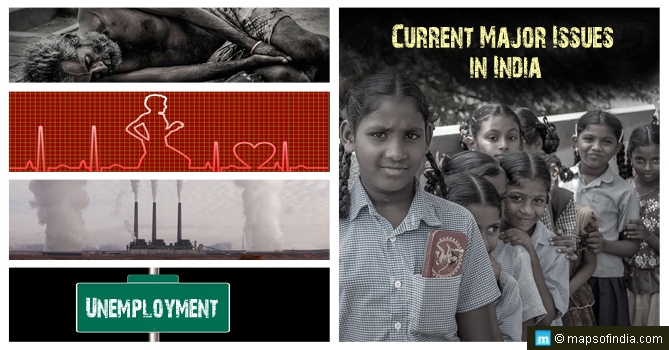

India is the biggest democracy in the world, which has taken giant strides in the last few decades. We are now the world’s third-largest economy (in purchasing power parity terms). However, being an Indian you can’t resist ‘chalta hai’ (let it be) common attitude. Moreover, for everything we have ‘jugaad’. But in between this, we can not forget everyday issues, which continue to pose hurdles in the progress of the nation. These social, political and economic issues are meant to be taken into consideration, in order to improve the prevailing condition of our society. Issues like corruption, crime, condition of the road network and so on, need to be looked into immediately. With the proliferation of information and technology, more awareness is spreading among the masses. New organisations are sprouting to find a fruitful solution to these problems. The activists involved are really working hard to eradicate these problems from their very roots.
So, we would like the government to come up with the solution to these problems faced by the common man
What are the current major issues in India?
Corruption
The most widely spread endemic in India is corruption, which must be handled quickly and wisely. There is hardly any office, in both the private and public sector, that is untouched from this disease. There is no telling how much loss the economy has suffered because of this. Though most of us are concerned, when the time comes to act, we, the people of India, should not be found lacking.
Illiteracy
The percentage of illiteracy in India is alarming. Though 74.04% of people were counted as literate in 2011 census, there is a wide disparity between rural and urban areas and male and female population. The condition in villages is worse than in cities. Though a number of primary schools have been set up in rural India, the problem persists. Many people who are counted as literate can barely read or write. Hence, providing education just to children won’t solve the problem of illiteracy, as many adults in India are also untouched by education.
Education System
The education system of India is blamed every now and then for being too theoretical, but not practical and skill-based. Students study to score marks, not to gain knowledge. This so-called modern education system was introduced by the colonial masters to create servants who could serve but not lead, and we still have the same education system. Rabindranath Tagore had written many articles offering suggestions to change the education system of India. But still, success is as elusive as ever.
Basic Sanitation
Sanitation is yet another problem, but one of the biggest, in India. There are about 700 million people who have no access to toilets at home. Slum areas do not have toilets. People are thus forced to defecate in the open, which causes numerous diseases like diarrhea, cholera, dehydration etc. Many rural schools also have no toilets, because of which parents do not send their kids, especially girls, to school. Due attention was drawn towards this problem by Gandhiji but nothing much was done. A growing population is the biggest challenge causing these problems. For example, the sewage system in Delhi was designed to meet the needs of a population of three million people. But Delhi now has more than 14 million of population. This is not just the case of Delhi; every state and region in India is the same.
Though 12 million toilets claim to have been built under Swachh Bharat Abhiyan in the last five years, as per a UN report, 44% of the population continues to defecate in the open. Sanitation, solid waste management, and drainage continue to pose challenges in India.
However, according to Swachh Bharat Mission website a total of 100 Million toilets were built in India, and all the States, Union Territories, Gram Panchayats, and Districts declared themselves Open Defecation Free (ODF).
Healthcare System
It is true that the world’s most populous democratic country cannot provide proper healthcare facilities to its entire population. India is becoming a hub for medical tourism but all these facilities are not available to local residents, who happen to be poor. Healthcare is a neglected issue in India, as major attention drawers are agriculture, infrastructure and IT. Lack of resources in rural India is a major concern of the day, leading to most of the problems. 50% of all villagers have no access to healthcare providers; Infant Mortality Rate (IMR) is 34 per 1000 live births; lack of nutrition caused stunning growth in 50% of all the babies, and 36% people in India have no access to toilets.
Despite the country’s medical tourism bringing in $2.8 billion in 2020 and being the fourth largest medical devices market, the healthcare system for the Indian citizen has been a disappointment. According to a report by NITI Aayog, the country has 1.3 hospitals bed per 1000 population with almost 50% of it concentrated in states like Karnataka, Telangana, Uttar Pradesh, Kerala, Tamil Nadu, and Maharashtra
Poverty
The population of India living below the poverty line declined from 37% in 2004-2005 to 22% in 2011-12 (Planning Commission data). In 2011-12, 22% of the population (one in five Indians) lived in extreme poverty. This figure is expected to decline to 5% by 2022, as per World Poverty Clock estimate. However, 80% of the poor in India live in villages. Rajasthan, Madhya Pradesh, Uttar Pradesh, Bihar, Jharkhand, Orissa, and Chhattisgarh have the poorest areas. 43% of the poor belong to Scheduled Caste or Scheduled Tribe categories, as per World Bank statistics (2016). This disparity needs immediate attention of the government.
Despite the World Poverty Clock claims of decline in poverty, the pandemic has made all all such predictions go wrong according to Pew Research Center there has been a significant decline of almost 32 million in the middle class due to the Pandemic in the country. The report also brings light on how the year of the pandemic has increased the number of poor (living on $2 or less) to have doubled from 59 million to 134 million.
Pollution
Pollution and environmental issues are the other challenges that India is facing at present. Though India is working hard, there is a long way to go. Degradation of land, depleting natural resources, and loss of biodiversity are the main issues of concern due to pollution. Untreated sewerage is the major cause of water pollution. The Ganga and Yamuna rivers are today two of the most polluted rivers in India. Same is the condition of other rivers that pass through populated cities. Additionally, increasing construction and vehicular traffic also contribute to pollution in the cities. India needs to embark on a model of sustainable development.
According to the World Air Quality report published in 2021, Three Indian cities (Bhiwadi, Ghaziabad and New Delhi) featured in the Top most polluted cities in the World. This stat is scary enough and requires government to take quick actions and not gamble with the health of the citizens.
Women’s Safety
Both men and women enjoy equal opportunities, but as far as freedom and safety of women are concerned, India lags behind. Issues like domestic violence, rape, the portrayal of women in media, etc., must be tackled immediately.
Infrastructure
India needs to work swiftly on its infrastructure development, towards better roads, affordable housing and services like water, sanitation, primary healthcare, etc. According to the Union budget 2021, the government has allocated Rs 233,083 crore to enhance the transport infrastructure. Adding to this, Government of India is also expanding the National Infrastructure Pipeline (NIP) and is expected to invest $1 trillion to boost the infrastructure.
Unemployment
Unemployment, nowadays, is very common among the youth. This situation is also known as joblessness. Moreover, it is a set of circumstances where an able-bodied person is willingly searching for a job but is not able to find it. We can calculate the percentage of unemployed people prevalent in the economy by dividing it with the number of individuals currently present in the labour force. The government of India must take the necessary steps to eradicate it by creating more government and public sector job opportunities. Also, it needs to support private sector industry that could provide jobs to the ones who really deserve it. As per the Centre for monitoring Indian Economy data, the rate of unemployment has touched 8.10% in February 2022. This rate of unemployment is high for a country like India. If not tackled immediately, it will become a challenge for our society and economy.
Agricultural Distress
India is a country which is widely famous for its agriculture throughout the world. But the sad plight of our country lies in the fact that here farmers face too many problems. Such as lack of basic amenities of irrigation systems, agricultural implements and short or long-term loans. The exploitation of farmers at the hands of moneylenders is a very prominent and common issue that immediately needs to be looked into. Stories of farmers committing suicide appear in the media almost every day. As per the India economic survey 2018, the estimated data states that the percentage of agricultural workers in the total workforce is likely to drop up to 25.7% by 2050 from 58.2% in 2001. Therefore, agriculture needs to be revived at the earliest.
The rise in Global Protectionism
India is still in its developing phase, on the way to becoming a developed nation. Our country is enthusiastically overcoming each and every challenge coming across its way. Some of the grievances listed by India against developed countries such as the US are the problems encountered by the exporters of IT services, and tariffs imposed on the exports of products like steel and aluminium by the US. The US has also imposed sanctions on the purchase of crude oil from Iran, which is likely to hamper the Indian economy and increase its import bill. Moreover, India faces a constant threat of tariffs from many countries, and pressure to open up its domestic market. Therefore, the newly formed government must take necessary steps to protect the interests of India from foreign powers, that are constantly interfering in all spheres.
To conclude, the government of India needs to create an ecosystem that enables private investments, increased consumption, the competitiveness of exports and swift infrastructural investment. These steps can catapult India to the status of a global superpower that it rightly deserves.
Related Link:
Extreme Poverty-Causes, Consequences & Government initiatives




